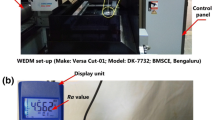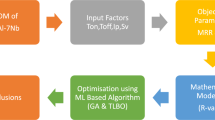Abstract
One of the challenges facing manufacturing industries is optimizing the power consumption for the development of sustainable manufacturing processes. To precisely measure the wire cut electric discharge matching (WEDM) performance of aluminum–silicon (Al–Si) alloy, the present study proposed a hybrid teaching and learning–based optimization (HTLBO) to take on the challenge. The HTLBO comprises teaching and learning–based optimization technique and graph theory algorithm to improve WEDM performance. The power consumption, kerf width, surface quality, and metal removal rate are considered performance characteristics. First, an auxiliary electrode was placed on the top surface of the Al–Si alloy and reduced surface defects including micro-cracks, micro-voids, and micro-globules from the machined surface around the kerf and also improved metal removal rate. The proposed methodology was used in the second stage and optimized the process parameters. The optimal working condition was as follows: 3.8 A of discharge current, 10 µs of discharge duration, 24 µs of discharge interval, 20 V of discharge voltage, and 17 N of wire tension. At optimal working condition, the metal removal rate, power consumption, surface roughness, and kerf width are found as 19.72 mm3/min, 49 W, 0.7 µm, and 351 µm, respectively. Moreover, the HTLBO took less time in optimization when compared with conventional TLBO.















Similar content being viewed by others
Data availability
The authors confirm that the data supporting the findings of this study are available within the article.
References
Samal P, Babu DM, Kiran SV, Surekha B, pandu RV, Mandal A (2021) Study of microstructural and machining characteristics of hypereutectic Al-Si alloys using Wire-EDM for photovoltaic application. Silicon 13:4407–4419
Yan H, Kabongo DB, Yan Z, Han F, Chen Z (2020) Sustainable production of high-uniformity workpiece surface quality in wire electrical discharge machining by fabricating surface microstructure on wire electrode. J Clean Prod 259(2020):120881
Dong S, Wang Z, Wang Y (2017) Research on micro-EDM with an auxiliary electrode to suppress stray-current corrosion on C17200 beryllium copper alloy in deionized water. Int J Adv Manuf Technol 93(1–4):857–867
Zhang G, Li W, Zhang Y, Huang Y, Zhang Z, Chen Z (2020) Analysis and reduction of process power consumption and thermal deformation in a micro-structure wire electrode electric discharge machining thin-wall component. J Clean Prod 244:118763
Papetti A, Menghi R, Domizio GD, Germani M, Marconi M (2019) Resources value mapping: a method to assess the resource efficiency of manufacturing systems. Appl Energy 249:326–342
Sharma P, Chakradhar D, Narendranath S (2021) Measurement of WEDM performance characteristics of aero-engine alloy using RSM-based TLBO algorithm. Meas 179:109483
He Y, Wu P, Li Y, Wang Y, Tao F, Wang Y (2020) A generic energy prediction model of machine tools using deep learning algorithms. Appl Energy 275:115402
Hynes NRJ, Kumar DSSP, Prabhu MV, Ali MA, Raza MH, Pruncu CI (2022) Investigating the parametric effects on wire electric discharge machining performance in processing AA1050–5 wt% SiC composite with zinc-coated brass wire. J Brazil Soc Mech Sci Eng 44(4):127
Gamage JR, Silva AKMD, Chantzis D, Antar M (2017) Sustainable machining: process energy optimisation of wire electro discharge machining of Inconel and titanium super alloys. J Clean Prod 164:642–651
Zheng J, Lai X, Chen A, Zheng W (2019) Energy modeling and minimizing power consumption control strategy of wire electrical discharge machining (WEDM) through electrical parameters. Int J Adv Manuf Technol 103:4341–4353
Ming W, Zhang Z, Wang S, Zhang Y, Shen F (2019) Comparative study of energy efficiency and environmental impact in magnetic field assisted and conventional electrical discharge machining. J Clean Prod 214:12–28
Venkatarao K, Kumar TA (2019) An experimental parametric analysis on performance characteristics in wire electric discharge machining of Inconel 718. Proc I Mech E Part C: J Mech Eng Sci 233(14):4836–4849
Venkatarao K, Ratna Raju L, Kiran Kumar C (2020) Modeling of kerf width and surface roughness in wire cut EDM of Ti-6Al-4V. Proc I Mech E Part E: J Proc Mech Eng 234(6):533–542
Kavimani V, Prakash KS, Thankachan T (2019) Multi-objective optimization in WEDM process of graphene – SiC-magnesium composite through hybrid techniques. Meas 145:335–349
Mouralova K, Prokes T, Benes L (2020) Analysis of the oxide occurrence on WEDM surfaces in relation to subsequent surface treatments. Proc I Mech E Part C: J Mech Eng Sci 234(3):721–733
Chen Z, Zhang Y (2019) Investigation on a novel surface microstructure wire electrode for improving machining efficiency and surface quality in WEDM. Int J adv Manuf tech 102:2409–2421
Gunen A, Ceritbinmez F, Patel K, Akhtar MA, Mukherjee S, Kancad E, Karakas MS (2022) WEDM machining of MoNbTaTiZr refractory high entropy alloy. CIRP J Manuf Sci Tech 38:547–559
Singh B, Misra JP (2019) Surface finish analysis of wire electric discharge machined specimens by RSM and ANN modeling. Meas 137:225–237
Shabgard M, Farzaneh S, Gholipoor A (2017) Investigation of the surface integrity characteristics in wire electrical discharge machining of Inconel 617. J Brazil Soc Mech Sci Eng 39:857–864
Nadeem AM, Siddiquee AN, Khan ZA, Khan NZ (2022) A comprehensive review on wire EDM performance evaluation. Proc I Mech Eng Part E: J Proc Mech Eng 236(4):1724–1746
Luo G, Ming W, Zhang Z, Liu M, Li H, Li Y, Yin L (2014) Investigating the effect of WEDM process parameters on 3D micron-scale surface topography related to fractal dimension. Int J Adv Manuf Tech 75:1773–1786
Naik S, Das SR, Dhupal D (2021) Experimental investigation, predictive modeling, parametric optimization and cost analysis in electrical discharge machining of Al-SiC metal matrix composite. SILICON 13:1017–1040
Teimouri R, Baseri H (2014) Optimization of magnetic field assisted EDM using the continuous ACO algorithm. Appl Soft Comp 14:381–389
Rao RV, Savsani VJ, Vakharia DP (2012) Teaching-learning-based optimization: a novel optimization method for continuous non-linear large scale problems. Inf Sci 183(1):1–15
Cheema MS, Dvivedi A, Sharma AK (2013) A hybrid approach to multicriteria optimization based on user’s preference rating. Proc I Mech E Part B: J Eng Manuf 227(11):1733–1742
Ranganayakulu J, Srihari PV, Rao KV (2022) An optimization strategy to improve performance in electrochemical discharge machining of borosilicate glass using graph theory algorithm and desirability index. SILICON 14(2022):5241–5254
Chung DK, Shin HS, Chu CN (2012) Modeling and experimental investigation for electrolytic corrosion prevention in high frequency micro EDM using deionized water. Micro Syst Technol 18:703–712
Ji X, Ye H, Zhou J, Yin Y, Shen X (2017) An improved teaching-learning-based optimization algorithm and its application to a combinatorial optimization problem in foundry industry. Appl Soft Comp 57:504–516
Rao RV, Savsani VJ, Vakharia DP (2011) Teaching-learning-based optimization: a novel method for constrained mechanical design optimization problems. Comp Aid Des 43(3):303–315
Venkatarao K (2021) The use of teaching-learning based optimization technique for optimizing weld bead geometry as well as power consumption in additive manufacturing. J Clean Prod 279:123891
Rao KV, Murthy P, Vidhu KP (2017) Assignment of weightage to machining characteristics to improve overall performance of machining using GTMA and utility concept. CIRP J Manuf Sci Tech 18:152–158
Chaitanya Reddy M, Venkata Rao K, Suresh G (2021) An experimental investigation and optimization of energy consumption and surface defects in wire cut electric discharge machining. J Alloy Comp 851:158
Zhang Y, Xu Z, Zhu D, Xing J (2015) Tube electrode high-speed electrochemical discharge drilling using low-conductivity salt solution. Int J Mach Tools Manuf 92:10–18
Smirnov A, Peretyagin P, Bartolome JF (2018) Wire electrical discharge machining of 3Y-TZP/Ta ceramic-metal composites. J Alloy Comp 739:62–68
Habib S, Okada A (2016) Study on the movement of wire electrode during fine wire electrical discharge machining process. J Mater Process Technol 227:147–152
Author information
Authors and Affiliations
Contributions
Dr. K Venkata Rao has supervised the experimentation and involved in optimization and manuscript preparation. Dr. M Chaitanya Reddy conducted experimentation and involved in analysis and manuscript preparation. Dr. Y Prasanna Kumar involved in optimization and analysis of experimental results. Dr. L Suvarna Raju prepared experimental plan and involved in analysis of experimental results and manuscript preparation. Dr. Bonula Rama Rao involved in the revision of manuscript and improved quality of the manuscript. Dr. Duppala Azad also involved in the revision of manuscript and improved quality of the manuscript.
Corresponding author
Ethics declarations
Ethics approval and consent to participate
Not applicable.
Consent for publication
Not applicable.
Conflict of interest
The authors declare no competing interests.
Additional information
Publisher's note
Springer Nature remains neutral with regard to jurisdictional claims in published maps and institutional affiliations.
Rights and permissions
Springer Nature or its licensor (e.g. a society or other partner) holds exclusive rights to this article under a publishing agreement with the author(s) or other rightsholder(s); author self-archiving of the accepted manuscript version of this article is solely governed by the terms of such publishing agreement and applicable law.
About this article
Cite this article
Venkatarao, K., Reddy, M.C., Kumar, Y.P. et al. Multi-response optimization in WEDM process of Al–Si alloy using TLBO-graph theory algorithm towards sustainability. Int J Adv Manuf Technol 126, 3679–3694 (2023). https://doi.org/10.1007/s00170-023-11355-8
Received:
Accepted:
Published:
Issue Date:
DOI: https://doi.org/10.1007/s00170-023-11355-8




